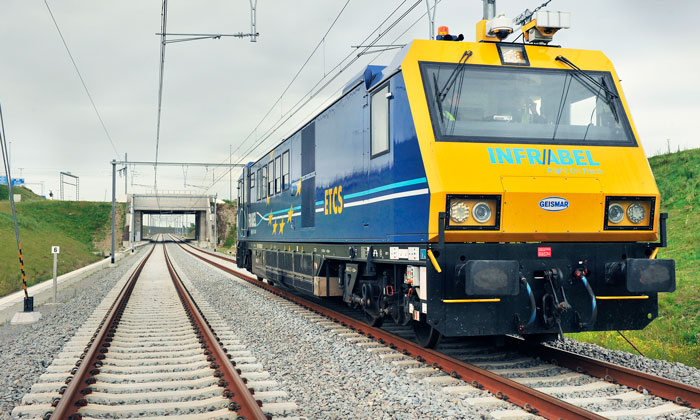Infrabel’s commitment to a smarter railway
Posted: 4 June 2018 | Luc Vansteenkiste - Infrabel | No comments yet
Infrabel, the Belgian rail infrastructure manager, is working hard on smarter maintenance and digitalising its rail infrastructure to ensure rail traffic in Belgium becomes even safer and of higher quality. For Global Railway Review, Luc Vansteenkiste, Director-General Asset Management, overviews the challenges and benefits of this gigantic transformation.


Smarter maintenance as the basis of maintenance
The Belgian railway network is one of the busiest in Europe, with 4,000 trains (passenger and freight) in operation every day. To guarantee safe and punctual rail traffic, Infrabel must regularly check, maintain and, where necessary, replace its rail infrastructure.
Smarter maintenance aims at more efficient and targeted maintenance of assets (rails, catenaries, points, signals and level crossings) by making maximum use of digitalisation in combination with new operational working methods and resources. To be able to manage all maintenance in a more targeted manner, we are working on the development of a gigantic digital platform.
Digitalisation via sensors and measuring trains
At the beginning of 2014, Infrabel began the step-by-step digitalisation of the entire Belgian railway network. This is our ‘Smart Railway’ project. We are making our localised infrastructure (points, signals and level crossings) ‘smarter’ by installing sensors everywhere. This infrastructure lends itself perfectly to the application of ‘embedded intelligence’ because it often concentrates on a specific location.
Special trains equipped with sensors and measuring equipment are also used to identify the maintenance requirements of the linear infrastructure (rails and catenaries). These trains and sensors collect all the data in a central database. On this basis, it can be predicted when the rail infrastructure will need to be maintained and renewed. Predictive maintenance is where we try to anticipate problems even before they arise.
Focusing on the safety of staff while working
An additional advantage is that the use of sensor-equipped trains means that Infrabel staff no longer have to manually check 6,500km of tracks, which naturally benefits safety. Of course, our railway staff will still need to intervene in the field to carry out the maintenance or to solve the problem.
The focus on increased efficiency is only possible if we make full use of modern tools, such as our ‘Mobile Maintenance Unit’. This is a work train consisting of two wagons: One for the transport of the tools and a second (without a floor) that is equipped as a fully-fledged workshop. This last wagon has laterally removable walls to increase the work space while ensuring safety in relation to train traffic on the adjacent track. Our staff can work in complete safety, even in harsh weather conditions.


Infrabel’s 3D simulator for training ‘lookout’ staff
One central database and tablets for use in the field
Smart Railway is implemented in close consultation with Infrabel’s maintenance teams and is designed to support them. All the information our maintenance staff need is sent to their tablets. Teams in the field can use their tablets to view component information, consult the required tasks, enter measurement data and take photos of any damage to the railway infrastructure.
In this way, Infrabel creates a single, large database that is a collection of all assets and their components, indicating, among other things, their age, condition, previous maintenance information and installation date. By digitally and centrally managing all information, we are able to monitor and therefore predict maintenance better and quicker. At the touch of a button, components that are nearing the end of their service life can be identified and integrated into a renewal programme.
European leader in innovation
Smart Railway is one of the largest digitalisation projects in Belgium and we are fully committed to smarter maintenance and digitalisation. We are one of the European leaders in this field. A recent international study by PricewaterhouseCoopers and Mainnovation showed that Infrabel is at the forefront of best practices and innovation in the field of rail infrastructure maintenance.
At the end of 2017, Infrabel received the Trends Digital Pioneers Award for Smart Railway, with the jury rewarding the innovative and progressive character of this digitalisation project. And at RailTech 2017, Infrabel received the Public Transport Innovation Award for the use of a simulator that works with virtual reality (3D) and is used to train so-called lookouts. These are employees who monitor the safety of their colleagues while they are carrying out track work.


Specially-equipped sensor and measuring trains help to predict problems before they occur
New rail pads halve the noise nuisance from train traffic
In addition, Infrabel has also developed a new generation of rail pads. These are small rubber pads that are placed between the concrete sleepers and the rails. They reduce the noise produced by a combination of trains and rail infrastructure by an average of three decibels. Compared with the previous rail pads, these new pads reduce the noise nuisance from rail traffic by 50 per cent.
The aim is to equip 100-150km of track a year, which corresponds to approximately 300,000 sleepers a year. With the new rail pads, Infrabel is proactively taking noise-reducing measures, and as a public company at the service of society, this is one of our priorities.
Digitalise fully and continue to evolve
Knowledge is power and to innovate is to progress. Digitalisation really does contribute towards improving the effectiveness and efficiency of maintenance and thus to a safer, more reliable and better-quality rail network.
In order to continue evolving, we are looking at other industries – such as the maintenance of wind farms in the North Sea – to permanently gain inspiration. By resolutely playing the digitalisation, Infrabel has entered the 21st century and is trying to set an example for other European rail infrastructure managers.
Biography










